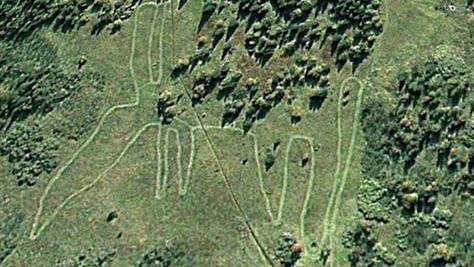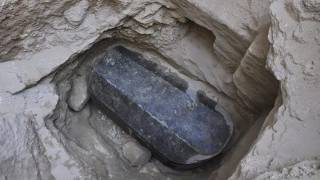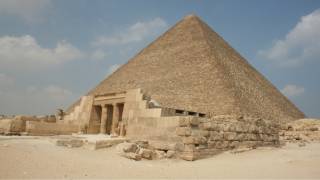Mysterious elk-shaped geoglyph discovered in Russia
Source: msnbc.msn.com
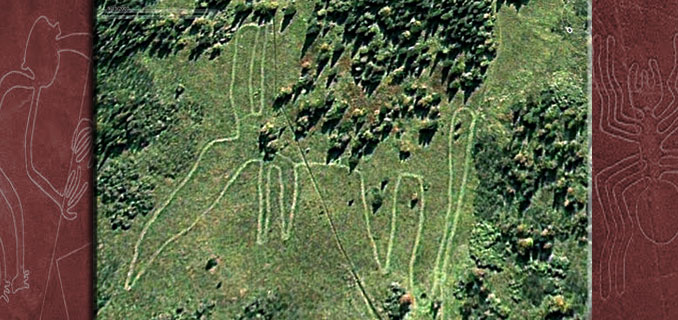
A huge geoglyph in the shape of an elk or deer discovered in Russia may predate Peru’s famous Nazca Lines by thousands of years.
The animal-shaped stone structure, located near Lake Zjuratkul in the Ural Mountains, north of Kazakhstan, has an elongated muzzle, four legs and two antlers. A historical Google Earth satellite image from 2007 shows what may be a tail, but this is less clear in more recent imagery.
Excluding the possible tail, the animal stretches for about 900 feet (275 meters) at its farthest points (northwest to southeast), the researchers estimate, equivalent to two American football fields. The figure faces north and would have been visible from a nearby ridge.
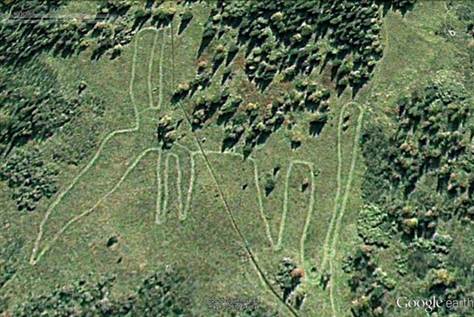
A historical Google Earth image from 2007, in this image it looks like the animal might have a tail.
"The figure would initially have looked white and slightly shiny against the green grass background," write Stanislav Grigoriev, of the Russian Academy of Sciences Institute of History & Archaeology, and Nikolai Menshenin, of the State Centre for Monument Protection, in an article first detailing the discovery published last spring in the journal Antiquity. They note that it is now covered by a layer of soil.
Fieldwork carried out this past summer has shed more light on the glyph’s composition and date, suggesting it may be the product of a "megalithic culture," researchers say. They note that hundreds of megalithic sites have been discovered in the Urals, with the most elaborate structures located on a freshwater island about 35 miles (60 km) northeast of the geoglyph.
Discovery & excavation
A man named Alexander Shestakov first discovered the glyphs using satellite images. He alerted researchers, who sent out a hydroplane and paraglider to survey the giant structure.
This has since progressed to an on-the-ground excavation by a team led by Grigoriev. They’ve found that the stone architecture of the geoglyph is quite elaborate. When they excavated part of a hind leg the largest stones were on the edges, the smaller ones inside. This past summer they also found the remains of passageways and what appear to be small walls on the hoof and muzzle of the animal.
"The hoof is made of small crushed stones and clay. It seems to me there were very low walls and narrow passages among them. The same situation in the area of a muzzle: crushed stones and clay, four small broad walls and three passages," Grigoriev wrote in an email to LiveScience. He cautioned that his team didn’t excavate all the way down to the bottom of the walls, not wishing to damage the geoglyph.
Dating the geoglyph
Among the finds from the excavations are about 40 stone tools, made of quartzite, found on the structure’s surface. Most of them are pickaxe-like tools called mattocks, useful for digging and chopping. "Perhaps they were used to extract clay," he writes in the email.
The style of stone-working called lithic chipping used on one artifact dates it to the Neolithic and Eneolithic (sixth to third millennia B.C.), though Grigoriev says the technology is more typical of the Eneolithic, between the fourth and third millennia B.C.
If that date is correct, it would make the geoglyph far older than Peru’s Nazca Lines, the very earliest of which were created around 500 B.C. Grigoriev added that current studies of ancient pollen at the site will help to narrow down the age.
In the Antiquity journal article, Grigoriev and Menshenin point out that palaeozoological studies show that the landscape in the southern Urals supported fewer trees in the Eneolithic, with forest growth not appearing until about 2,500 years ago. "This means that there were open landscapes in the Eneolithic and Bronze Age, which allowed the hill figure to be created," they write.
A megalithic culture
Researchers say this geoglyph may have been built by a "megalithic culture" in the region that created stone monuments in prehistoric times.
"[M]any megalithic sites with features in common with European megaliths have been located: Some 300 are known but have not yet been studied in detail," write Grigoriev and Menshenin in the Antiquity article. Among these megaliths are numerous "menhirs," large upright standing stones.
The most spectacular megalithic complexes are on the relatively small Vera Island, located on Turgoyak Lake, about 35 miles (60 km) northeast of the geoglyph.
[...]
Read the full article at: msnbc.msn.com
Geoglyphs
A geoglyph is a large design or motif (generally longer than 4 meters) produced on the ground and typically formed by clastic rocks or similarly durable elements of the landscape, such as stones, stone fragments, gravel, or earth. A positive geoglyph is formed by the arrangement and alignment of materials on the ground in a manner akin to petroforms, while a negative geoglyph is formed by removing patinated clasts to expose unpatinated ground in a manner akin to petroglyphs.
Source
Nazca Lines:
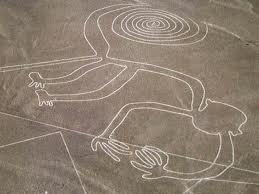
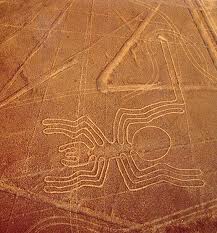
The Nazca Lines /ˈnæzkə/ are a series of ancient geoglyphs located in the Nazca Desert in southern Peru. They were designated as a UNESCO World Heritage Site in 1994. The high, arid plateau stretches more than 80 kilometres (50 mi) between the towns of Nazca and Palpa on the Pampas de Jumana about 400 km south of Lima. Although some local geoglyphs resemble Paracas motifs, scholars believe the Nazca Lines were created by the Nazca culture between 400 and 650 AD.[1] The hundreds of individual figures range in complexity from simple lines to stylized hummingbirds, spiders, monkeys, fish, sharks, orcas, and lizards.Source
The lines are shallow designs made in the ground by removing the reddish pebbles and uncovering the whitish/grayish ground beneath. Hundreds are simple lines or geometric shapes; more than seventy are zoomorphic designs of animals such as birds, fish, llamas, jaguar, monkey, or human figures. Other designs include phytomorphic shapes such as trees and flowers. The largest figures are over 200 metres (660 ft) across.
Marree Man, or Stuart’s Giant :
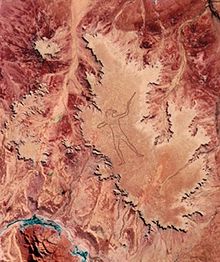
A modern geoglyph discovered by air on 26 June 1998. It appears to depict an indigenous Australian man, most likely of the Pitjantjatjara tribe,[citation needed] hunting birds or wallabies with a throwing stick. It lies on a plateau at Finnis Springs 60 km west of the township of Marree in central South Australia. [...]Source
Although it is the second largest geoglyph (and largest non-commercial geoglyph) in the world, its origin remains a mystery, with not a single witness to any part of the expansive operation.
The Marree Man geoglyph depicts a man holding either a throwing stick once used to disperse small flocks of birds, or a boomerang.
The lines of the figure were 20–30 cm deep at the time of discovery and up to 35 metres wide.
Cerne Abbas Giant:
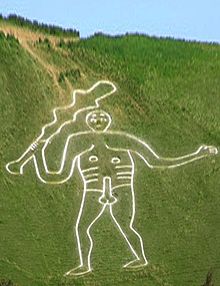
The Cerne Abbas Giant is a hill figure near the village of Cerne Abbas in Dorset, England. Made by a turf-cut outline filled with chalk, it depicts a large, naked man, typically described as a giant, wielding a club. The figure is listed as a scheduled monument in the United Kingdom and the site in which he sits is owned by the National Trust.Source
The figure has been the subject of much study and speculation, however its origin and age are unclear. It is often thought of as an ancient construction, though the earliest mention of it dates to the late 17th century. Early antiquarians associated it, on little evidence, with a Saxon deity, while other scholars sought to identify it with a Celtic British figure or the Roman Hercules, or some syncretization of the two. Archaeological evidence that parts of the drawing have been lost over time strengthen the Hercules identification. However the lack of earlier descriptions lead modern scholars to conclude it may date to the 17th century, and perhaps originated as political satire.
Regardless of its age, the Cerne Abbas Giant has become an important part of local culture and folklore, which often associates it with fertility. It is one of England’s best known hill figures and is a major visitor attraction in the region.
Uffington White Horse :
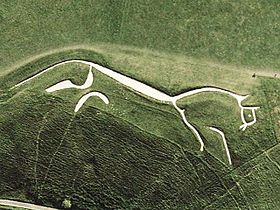
The Uffington White Horse is a highly stylized prehistoric hill figure, 110 m long (374 feet), formed from deep trenches filled with crushed white chalk. The figure is situated on the upper slopes of White Horse Hill in the English civil parish of Uffington (in the county of Oxfordshire, historically Berkshire), some 8 km (5 mi) south of the town of Faringdon and a similar distance west of the town of Wantage. The hill forms a part of the scarp of the Berkshire Downs and overlooks the Vale of White Horse to the north. Best views of the figure are obtained from the air, or from directly across the Vale, particularly around the villages of Great Coxwell, Longcot and Fernham.Source
The figure has been shown to date back some 3,000 years, to the Bronze Age, by means of optically stimulated luminescence dating carried out following archaeological investigations in 1994.
Goddess of the North:
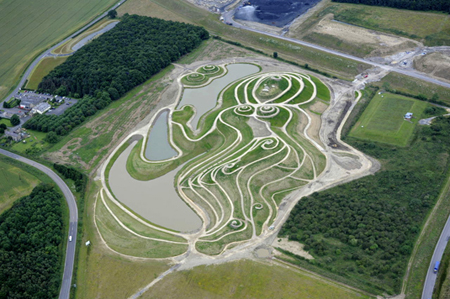
2012 - Northumberlandia, which is being called the world’s largest human landform, will officially open today. Also know as “The Lady of the North,” the land sculpture of a reclining lady will be unveiled by Princess Anne.Source
The sculpture is part of a 46-acre park with four miles of footpaths open to the public. Northumberlandia is a unique sculpture that was made from the land in the park. [...]
Made of 1.5 million tons of rock, clay and soil, The Lady of the North is 100 ft. high and a quarter of a mile long.
Tune into Red Ice Radio:
David Flynn - The Giant’s Geoglyphs of Tiahuanaco
George J. Haas & William R. Saunders - The Martian Codex
Dennis Price - The Dark Side of Stonehenge
